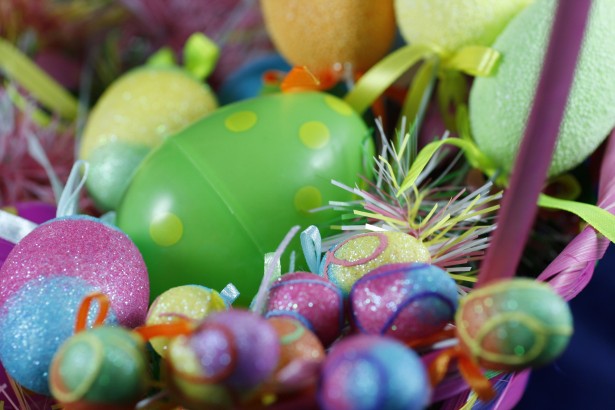The Easter Bunny
Perhaps the most notable secular symbol of the Easter season, the Easter Bunny has several possible origins. One potential explaination for the tradition dates back to a German folktale of an egg-laying hare called an “Osterhase,” who lays brightly-colored eggs. Over time, the bunny became known for bringing gifts of candy and sweets along with the eggs.
Another explanation revolves around Eostre, the pagan goddess of fertility and spring. According to the legend, Eostre found a wounded bird dying from the cold and transformed it into a rabbit so that it would stay warm. However, the rabbit continued laying eggs.

Easter Baskets
In the German tradition, while awaiting the egg-laying bunny, Osterhase, German children would build nests for the mythical creature to lay its brightly-colored eggs. These nests became the precursor to the vibrantly-colored baskets filled with plastic grass now used by children in the 21st century.

Easter Eggs
No one is completely sure where Easter eggs first got their start in the modern Easter tradition. Many speculate it’s because eggs are commonly associated with the Christian teaching of Jesus’s resurrection from the dead, as the egg symbolizes the tomb Christ was laid in. Others say the tradition is derived from the fact that eating eggs was previously forbidden during the season of Lent. Following the 40-day Lenten period, people as far back as the 1200s would then decorate the eggs to mark the end of Lent before eating them on Easter Sunday.

Jelly Beans
Ranked among the top Easter candies, Jelly Beans are modeled after colored eggs. More than 16 billion of the little gummy sweets are made each year for Easter, according to the National Confectioners Association.

Easter Lilies
Not surprisingly, the large, pure-white Easter lily has come to be known as a symbol of Christ’s resurrection, having been referenced by Jesus himself in the Gospel of Luke: "Consider the lilies how they grow: they toil not, they spin not; and yet I say unto you, that Solomon in all his glory was not arrayed like one of these."
But what you might not know is that prior to the 1940s, the vast majority of Eater lilies were grown in Japan. Following the attack on Pearl Harbor and the subsequent war in the Pacific, Easter lilies became nearly impossible to come by in the United States.
.jpg)
Easter Egg Hunts
Easter egg hunts are an old tradition that some say began with Protestant reformer Martin Luther. According to the story, Luther organized egg hunts during the Easter season to mimic how one hunts for Christ in the tomb, only to find it empty – even though modern Easter eggs are usually filled with small candies.
Easter egg hunts have become hugely popular in modern culture, ranging from small events in backyards across America to large-scale events on the White House grounds. According to the Guiness Book of World Records, the largest Easter egg hunt on record goes to Cypress Gardens Adventure Park in Winter Haven, Fla., where 9,753 children searched for 501,000 eggs in 2007.
